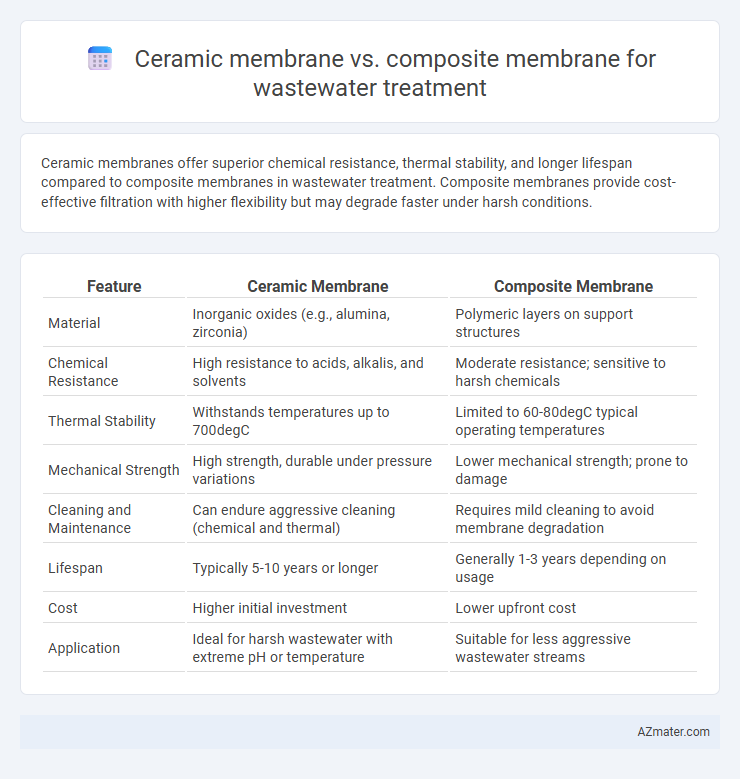Ceramic membranes offer superior chemical resistance, thermal stability, and longer lifespan compared to composite membranes in wastewater treatment. Composite membranes provide cost-effective filtration with higher flexibility but may degrade faster under harsh conditions.
Table of Comparison
| Feature | Ceramic Membrane | Composite Membrane |
|---|---|---|
| Material | Inorganic oxides (e.g., alumina, zirconia) | Polymeric layers on support structures |
| Chemical Resistance | High resistance to acids, alkalis, and solvents | Moderate resistance; sensitive to harsh chemicals |
| Thermal Stability | Withstands temperatures up to 700degC | Limited to 60-80degC typical operating temperatures |
| Mechanical Strength | High strength, durable under pressure variations | Lower mechanical strength; prone to damage |
| Cleaning and Maintenance | Can endure aggressive cleaning (chemical and thermal) | Requires mild cleaning to avoid membrane degradation |
| Lifespan | Typically 5-10 years or longer | Generally 1-3 years depending on usage |
| Cost | Higher initial investment | Lower upfront cost |
| Application | Ideal for harsh wastewater with extreme pH or temperature | Suitable for less aggressive wastewater streams |
Introduction to Membrane Technology in Wastewater Treatment
Ceramic membranes in wastewater treatment offer high chemical and thermal resistance, making them ideal for harsh industrial effluents, whereas composite membranes provide cost-effective solutions with enhanced flexibility and mechanical strength. Membrane technology relies on selective separation mechanisms such as microfiltration, ultrafiltration, and nanofiltration to efficiently remove contaminants, suspended solids, and pathogens from wastewater. Optimizing membrane choice between ceramic and composite types depends on specific wastewater characteristics, operational conditions, and desired treatment outcomes.
Overview of Ceramic Membranes
Ceramic membranes, made from inorganic materials such as alumina, zirconia, or titania, offer high chemical, thermal, and mechanical stability, making them ideal for harsh wastewater treatment environments. These membranes provide superior resistance to fouling and withstand aggressive cleaning procedures, enhancing lifespan and operational efficiency in treating industrial effluents. Compared to composite membranes, ceramic membranes deliver consistent permeability and selectivity, especially in applications involving high temperatures and extreme pH conditions.
Overview of Composite Membranes
Composite membranes for wastewater treatment combine a thin selective layer with a porous support to enhance filtration efficiency and mechanical strength. These membranes typically feature polymeric materials like polyamide or polysulfone layered over a robust substrate, enabling effective removal of contaminants such as bacteria, organic compounds, and suspended solids. Their cost-effectiveness, flexibility, and resistance to fouling make composite membranes a popular choice for large-scale and diverse wastewater treatment applications.
Key Material Properties: Durability and Stability
Ceramic membranes exhibit superior durability and chemical stability due to their inorganic composition, making them highly resistant to harsh wastewater environments and thermal fluctuations. Composite membranes, typically made from polymeric materials, offer flexibility but are more prone to degradation and fouling under aggressive chemical and temperature conditions. The enhanced mechanical strength and long lifespan of ceramic membranes significantly reduce operational downtime and maintenance costs in wastewater treatment processes.
Filtration Performance: Efficiency and Selectivity
Ceramic membranes exhibit superior filtration performance in wastewater treatment due to their high chemical and thermal stability, enabling efficient removal of contaminants with consistent selectivity even under harsh operating conditions. Composite membranes offer enhanced selectivity with tailored polymer layers, providing effective separation of organic and inorganic pollutants but may suffer from lower durability compared to ceramic membranes. The choice between ceramic and composite membranes depends on balancing the need for high flux, fouling resistance, and specific contaminant rejection efficiency in targeted wastewater applications.
Chemical and Thermal Resistance Comparison
Ceramic membranes exhibit superior chemical resistance, withstanding extreme pH levels from 0 to 14, making them ideal for harsh wastewater treatment environments where strong acids or alkalis are present. Composite membranes, typically made from polymeric materials, have limited chemical resistance and can degrade when exposed to aggressive chemicals or oxidizing agents. In terms of thermal resistance, ceramic membranes tolerate high temperatures up to 700degC, ensuring stable operation during sterilization and high-temperature processes, whereas composite membranes generally operate below 60-80degC due to polymer thermal limitations.
Fouling Resistance and Cleaning Methods
Ceramic membranes exhibit superior fouling resistance in wastewater treatment due to their hydrophilic surface and chemical stability, allowing effective operation in harsh conditions. Composite membranes, while more cost-effective, are prone to fouling from organic and biological contaminants and typically require gentler cleaning methods such as backwashing and chemical cleaning with mild reagents. Cleaning ceramic membranes involves aggressive procedures including high-temperature chemical cleaning and ultrasonic cleaning, ensuring prolonged membrane lifespan and consistent performance.
Cost Analysis: Installation and Maintenance
Ceramic membranes typically have higher upfront installation costs due to their durable materials and robust construction, but they offer longer service life and lower frequency of replacements, reducing overall maintenance expenses. Composite membranes present lower initial investment costs but often require more frequent cleaning and replacement, which can increase long-term operational expenses. Evaluating total cost of ownership favors ceramic membranes for high-demand wastewater treatment applications where durability and less downtime are critical.
Environmental Impact and Sustainability
Ceramic membranes exhibit higher chemical and thermal resistance, resulting in longer lifespan and reduced waste generation compared to composite membranes in wastewater treatment. Composite membranes often require more frequent replacement due to lower durability, increasing landfill burden and resource consumption. Ceramic membranes support sustainable practices by enabling efficient pollutant removal with less frequent material turnover and lower overall environmental footprint.
Applications and Case Studies in Wastewater Treatment
Ceramic membranes exhibit superior chemical and thermal resistance, making them ideal for harsh wastewater streams such as those in petrochemical and pharmaceutical industries, where case studies demonstrate prolonged operational lifespan and minimal fouling. Composite membranes offer cost-effective solutions with high permeability, widely applied in municipal wastewater treatment plants for nutrient removal and organic matter degradation, supported by several successful pilot projects showcasing scalability and efficiency. Comparative analyses reveal ceramic membranes' advantage in treating high-strength industrial effluents, while composite membranes excel in large-scale urban wastewater scenarios with variable loadings.

Infographic: Ceramic membrane vs Composite membrane for Wastewater treatment
 azmater.com
azmater.com